Acne, the bane of many adolescents and adults alike, is an exceedingly prevalent skin condition that affects millions worldwide.
Beyond being a source of frustration and self-consciousness, acne can significantly impact one's physical and emotional well-being. Yet, understanding acne involves delving beyond its surface-level appearance. When it comes to finding the right remedy for your acne issues, it’s important to know and understand the diverse range of acne types, as each type has its own distinct causes and treatment strategies.
In this blog, we’ll be covering just that, so that you can be better equipped to take action that will lead you to clearer and healthier skin. If you’re ready to find the solutions to manage your own acne, join us in today’s blog as we navigate the intricate world of acne, one pimple at a time.
What is acne?
Before we dive into the specific types of acne, we’re first going to give you a general breakdown of acne and its causes. Acne is defined as a chronic skin disorder characterized by the formation of various types of pimples, such as blackheads, whiteheads, pustules, cysts, and nodules, often accompanied by inflammation and redness.
While it may seem like a mere cosmetic concern, acne's impact extends far beyond the surface of the skin, affecting an individual's self-esteem, mental well-being, and overall quality of life.
To better comprehend the intricacies of acne, let’s go a little deeper into the parts of the skin that are related to acne. Certain areas of your skin contain what are called sebaceous glands, which are tiny but mighty organs nestled within each hair follicle. These sebaceous glands are responsible for producing sebum, an oily substance that serves as a natural skin lubricant. Sebum is essential for maintaining skin hydration and creating a protective barrier that keeps external aggressors out. Although sebum serves the essential function of forming a protective and hydrating barrier for the skin, when its production is out of balance and/or the skin’s cleanliness is not maintained well, the risk for acne breakouts increases dramatically.
Let us explain what the relationship between sebaceous glands, hair follicles, and acne is. Hair follicles, which cover our bodies, house the hair shaft and are connected to sebaceous glands. Normally, sebum flows through the hair follicle to reach the skin's surface, moisturizing and shielding the skin along the way. However, trouble brews when this process goes awry.
In individuals prone to acne, a complex interplay of factors disrupts the harmonious flow of sebum. This disruption often begins with the overproduction of sebum via sebaceous glands that have become hyperactive due to hormonal imbalances, genetics, or even environmental factors. As excess sebum accumulates within the hair follicle, it combines with dead skin cells and grime, forming a sticky mixture that obstructs the follicle's opening. This obstruction is the catalyst for the formation of comedones, also known as blackheads, which are the precursor to various types of acne lesions. But, as we mentioned, it’s not just the external elements that can cause acne — frequently the formation of acne begins from within, aka your hormones.
When it comes to acne, the role of hormones cannot be overstated. Hormones, the chemical messengers that regulate numerous bodily functions, exert a profound influence on the skin's condition. One key hormonal player in the occurrence of acne is androgens, the male sex hormones that are present in both males and females. Androgens stimulate the sebaceous glands to produce more sebum and become particularly active during puberty. That’s why the appearance of acne during the adolescent years is so much more prominent.
The hormonal influence doesn't stop at androgens. Other hormones, including insulin-like growth factor-1 (IGF-1), insulin, and certain pro-inflammatory hormones, can also further exacerbate acne. The release of insulin and IGF-1 can be triggered by high-glycemic diets (i.e. diets that contain high amounts of refined sugar and food such as white rice and white bread). When these hormones are released, sebum production and inflammation occur, which then fuel the acne fire.
For females, in particular, there are additional ways in which hormonal fluctuations occur that contribute to acne breakouts:
-Menstrual cycles, which can lead to cyclical acne outbreaks
-Polycystic Ovary Syndrome (PCOS), a common endocrine disorder among women of reproductive age, which can also lead to persistent hormonal imbalances
-Oral contraceptives, which can also influence hormone levels and potentially contribute to acne development (conversely, some women take oral contraceptives to help control hormones and acne outbreaks. Consult with a doctor or medical professional if you are taking contraceptives or are considering taking them)
In sum, acne is not merely a superficial skin concern; it's a labyrinth of multiple parts involving sebaceous glands, hair follicles, and hormones. By understanding the intricate relationship between these elements, we can begin to unravel the mysteries of acne, paving the way for effective prevention and treatment strategies that go beyond the surface and address the root causes.
Now that we’ve gotten a general overview of some of the different anatomy and causes of acne, let’s go into the specific types of acne that can occur and their remedies.
Acne Vulgaris is the most common type of acne and is characterized by the formation of various blemishes, such as blackheads, whiteheads, pustules, and cysts.
This type of acne is caused by the excessive sebum production of sebaceous glands. As we mentioned previously, the heightened levels of sebum can clog hair follicles, which leads to clogged pores, as sebum combines with dead skin cells and debris. Within these clogged pores, a bacterium naturally present on the skin called Propionibacterium acnes, can proliferate and trigger inflammation and infection.
Fortunately, an arsenal of remedies exists to combat this type of acne. Consider the following options:
-Topical treatments like benzoyl peroxide and salicylic acid help, to reduce acne-causing bacteria and keep your pores clear
-Keeping your skin hydrated throughout the day with quality moisturizers, to help prevent your sebaceous glands from producing excess sebum that will clog your pores
-Using a gentle, anti-inflammatory scrub once or twice a week to remove dirt, excess skin cells, and grime, to help unblock pores and prevent blackheads and acne from forming
-Keep your skin clean from acne-promoting bacteria with a gentle non-foaming cleanser that will keep your skin barrier well-maintained
If you believe that the type of acne you’re dealing with is acne vulgaris, try some of the remedies we mentioned above to achieve clear, healthy skin.
Cystic Acne is a particularly severe form of acne that manifests as deep, painful, and inflamed cysts or nodules beneath the skin's surface, often devoid of a visible whitehead or blackhead. These cysts can be significantly larger and more stubborn than typical acne lesions, causing considerable discomfort and leaving behind deep, sometimes permanent scars.
The causes of cystic acne are multifaceted. Hormonal imbalances, particularly an increase in androgens, can stimulate excess sebum production and the formation of cysts. Diet can also exacerbate the condition, with high-glycemic foods and dairy products in particular influencing hormone levels and sebum production. Due to the severity of cystic acne, it often requires a more comprehensive approach.
For the following remedies, you must consult with a doctor or medical professional beforehand:
-Prescription medications like isotretinoin, which may help to regulate sebum production and reduce inflammation
-Topical treatments such as corticosteroids, which can be used to target specific cysts and alleviate pain
-Dermatological procedures like drainage and corticosteroid injections, which may be necessary for more severe cases to prevent scarring and promote healing
If you’d like to try reducing cystic acne before seeing a professional about it, you can try eliminating or drastically reducing the amount of high-glycemic foods and dairy products, to balance your hormone levels and sebum production.
Here’s a list of common foods that are have a high glycemic index:
-White and whole wheat bread
-White rice
-Breakfast cereals and cereal bars
-Cakes, cookies, and sweet treats
-Potatoes and fries
-Chips and rice crackers
If the acne you have fits the description above, then you may have cystic acne. Consider adjusting your diet and/or seeing a dermatologist to give you professional advice on how to proceed with remedying this type of acne.
Comedonal acne, which consists of blackheads and whiteheads, presents a distinct facet of acne characterized by the formation of comedones, which are clogged hair follicles or pores. If you’re thinking, “Wait a minute, this sounds just like acne vulgaris…”, you’re not wrong. Comedonal acne does fall under the umbrella of acne vulgaris, but the primary difference between the two is that acne vulgaris presents inflamed lesions, while comedonal acne consists strictly of non-inflamed blackheads and white heads.
Blackheads, also known as “open comedones”, are defined by their dark or black appearance on the skin's surface, which occurs because of the trapped dead skin cells being exposed to air and oxidizing. In contrast, whiteheads, or “closed comedones”, are small, flesh-colored bumps that remain closed, trapping sebum and dead skin cells within the follicle (and since they are not exposed to air, they do not turn black).
These two forms of acne share a common cause—excess sebum production by the skin's sebaceous glands, coupled with the accumulation of dead skin cells. Poor skincare routines that fail to adequately cleanse and exfoliate the skin can exacerbate this condition. Fortunately, numerous remedies exist to address comedonal acne, such as:
-Topical retinoids, such as retinol or tretinoin, which can help regulate cell turnover, preventing the clogging of follicles
-Regular exfoliation with gentle scrubs or chemical exfoliants aids in keeping the pores clear and preventing new comedones from forming.
-If you’d like extra assistance, you can consult with a dermatologist to receive a professional extraction to clear stubborn comedones safely
Understanding the nuances between blackheads and whiteheads and their shared causes empowers individuals to adopt an effective skincare regimen, ensuring that their skin remains free from these common comedonal acne lesions. Try out the remedies we mentioned above or speak to a dermatologist to see what option may work best for your skin.
Hormonal acne, a distinct subtype of acne, is defined by its intimate connection to hormonal imbalances within the body. This type of acne typically manifests as deep, inflamed pimples that often appear along the jawline, chin, and lower cheeks, and may be more resistant to traditional acne treatments.
Its development is closely linked to hormonal fluctuations, making it most common during key life stages such as puberty, the menstrual cycle, and pregnancy. Hormonal disorders such as Polycystic Ovary Syndrome (PCOS) can also contribute to the onset of hormonal acne due to elevated androgen levels. Additionally, certain hormone-related medications, like corticosteroids or oral contraceptives, can influence hormone balance and potentially trigger acne outbreaks.
Rather than relying on topical treatments, remedying hormonal acne often requires addressing the underlying hormonal factors. Consider these following options (which require you to consult with a medical professional to receive):
-Hormonal therapy, such as birth control pills, can help regulate hormone levels and reduce acne severity
-Spironolactone, an androgen blocker, may also be prescribed to control excess androgens
If you’d like to take matters into your own hands first before seeking the help of a professional, consider making lifestyle adjustments, such as adopting a more balanced diet (see diet recommendations under the section regarding cystic acne) and managing stress, to support hormonal balance and alleviate hormonal acne.
Understanding the distinctive characteristics and underlying hormonal causes of this type of acne is crucial for individuals seeking effective remedies to achieve clearer, healthier skin. If this is you, try some of the steps we recommended to see if it makes a difference in your hormonal acne.


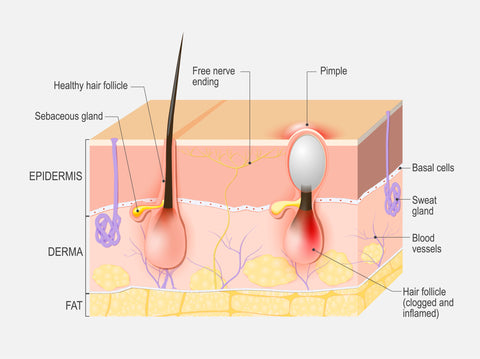

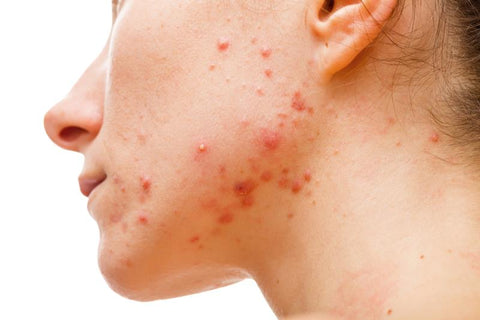
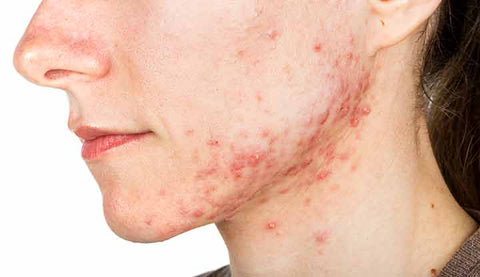

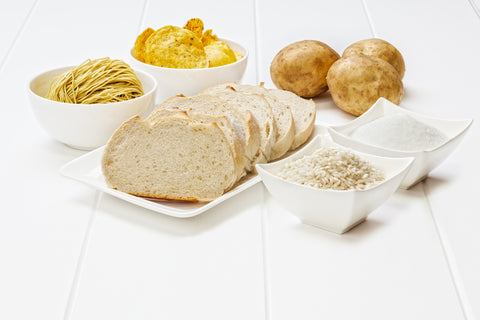

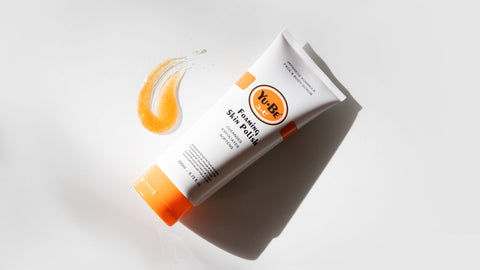
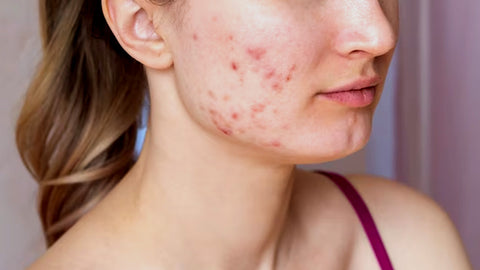
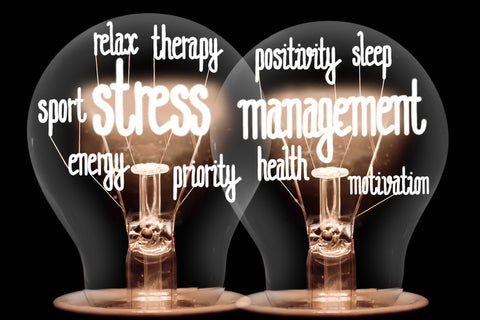
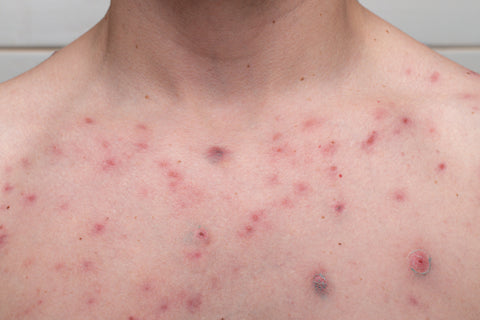
Comments (0)
Back to Skincare Tips